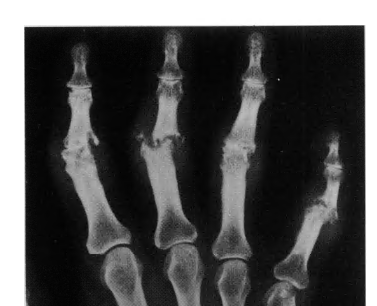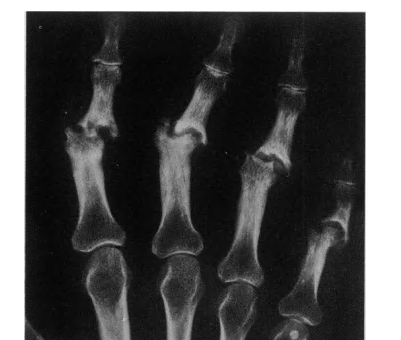Erosive Arthritis (Osteoarthritis not rheumatoid), ray peats article + case report in fingers using thyroid
-
Also on substack https://cs3001.substack.com/p/arthritis-and-the-effects-of-thyroid
https://raypeat.com/articles/articles/tissue-destruction.shtml
A very healthy 71 year-old man was under his house repairing the foundation, when a support slipped and let the house fall far enough to break some facial bones. During his recovery, he developed arthritis in his hands. It is fairly common for arthritis to appear shortly after an accident, a shock, or surgery, and Han Selye's famous work with rats shows that when stress exhausts the adrenal glands (so they are unable to produce normal amounts of cortisone and related steroid hormones), arthritis and other "degenerative" diseases are likely to develop.
But when this man went to his doctor to "get something for his arthritis," he was annoyed that the doctor insisted on giving him a complete physical exam, and wouldn't give him a shot of cortisone. The examination showed low thyroid function, and the doctor prescribed a supplement of thyroid extract, explaining that arthritis is one of the many symptoms of hypothyroidism. The patient agreed to take the thyroid, but for several days he grumbled about the doctor 'fixing something that wasn't wrong' with him, and ignoring his arthritis. But in less than two weeks, the arthritis had entirely disappeared. He lived to be 89, without a recurrence of arthritis. (He died iatrogenically, while in good health.)
Hypothyroidism presenting as destructive arthropathy of the fingers
She was initially believed to have rheumatoid arthritis but non-steroidal anti-inflammatory drugs were of no help
The patient was subsequently found to have hypothyroidism and erosive osteoarthritis of the fingers. Joint swelling, pain and stiffness responded dramatically to thyroid hormone substitution. The PIP joint spaces reappeared on the radiographs within 9 months.
1981 the joint spaces at the middle are closed

Next year after restoring thyroid, space between the joints

From the beginning of November 1981, the patient was treated with 1-thyroxine in gradually increasing doses to 100 ug/d. Thyroxine replacement was followed within 3 months by the disappearance of the symptoms of hypothyroidism.
In March 1982, the swelling of the joints had disappeared and the grip strength had increased to 140mmHg. During the following months, the patient remained well, without stiffness or pain except on maximum flexion of the fingers. She remains well at follow-up examination 2 years later.
Radiographs of the hands in July 1982 showed that the soft tissue swelling had disappeared and there was marked subchondral sclerosis with well defined articular margins. The articular spaces had become visible. No progression of the erosions could be seen; osteophytes were prominent around the PIP joints of both index fingers and the right middle (Figure 2). MCP, DIP and wrist joints remained normal.She still had leftover osteophytes / calcium deposits, if thats a problem famotadine or cimetidine might be able to clear this
https://journals.sagepub.com/doi/pdf/10.1177/2309499017717193
Calcific periarthritis or calcific tendinitis occurs most frequently in the shoulder and rarely in the elbow. Cimetidine was previously reported to be effective for chronic calcific periarthritis of the shoulder. Here, we present five patients with chronic calcific periarthritis of the elbow treated by administration of cimetidine; there were six affected elbows in these five patients. Although all patients had been treated with nonsteroidal anti-inflammatory drugs for at least 3 months, their symptoms were not relieved.
All patients took oral administration of cimetidine 400 mg daily. The pain was completely relieved in an average of 1.8 months after the administration of cimetidine, and the calcification of the elbow disappeared in an average of 5.1 months. During the follow-up period, there were no symptoms suggesting a recurrence. Although the detailed mechanism of action of cimetidine on periarticular calcifications remains to be understood, cimetidine appears to be a potential therapeutic agent for chronic calcific periarthritis^ also famotidine is a carbonic anhydrase inhibitor (CA is biomarker for vascular calcification), carbon dioxide helps clear calcium.
so co2 baths for the hands might help too but idk how deep it getsIGF-1 plays a key role in cartilage repair but IGF-1 binding protein often elevated in osteoarthritis which diminishes its repair effects. Thyroid can raise igf-1, maybe it gets around this effect somehow e.g thyroid hormone increases igf receptor density in some areas https://pubmed.ncbi.nlm.nih.gov/2152872/
adding some orange juice daily for the hesperedin which can help restore igf-1 levels in older age might be a plusThyroid + Famotadine should be effective for osteoarthritis restoration
Selye's work with the diseases of stress, and the anti-stress hormones of the adrenal cortex, helped many scientists to think more clearly about the interaction of the organism with its environment, but it has led others to focus too narrowly on hormones of the adrenal cortex (such as cortisol and cortisone), and to forget the older knowledge about natural resistance. There are probably only a few physicians now practicing who would remember to check for hypothyroidism in an arthritis patient, or in other stress-related conditions. Hypothyroidism is a common cause of adrenal insufficiency, but it also has some direct effects on joint tissues. In chronic hypothyroidism (myxedema and cretinism), knees and elbows are often bent abnormally.
Stress-induced cortisone deficiency is thought to be a factor in a great variety of unpleasant conditions, from allergies to ulcerative colitis, and in many forms of arthritis. The stress which can cause a cortisone deficiency is even more likely to disturb formation of progesterone and thyroid hormone, so the fact that cortisone can relieve symptoms does not mean that it has corrected the problem.Besides many people whose arthritis improved with only thyroid supplementation, I have seen 30 people use one or more of these other natural hormones for various types of arthritis, usually with a topical application. Often the pain is relieved within a few minutes. I know of several other people who used progesterone topically for inflamed tendons, damaged cartilage, or other inflammations. Only one of these, a woman with rheumatoid arthritis in many joints, had no significant improvement. An hour after she had applied it to her hands and feet, she enthusiastically reported that her ankle had stopped hurting, but after this she said she had no noticeable improvement.
-
@cs3000 said in Erosive Arthritis (Osteoarthritis not rheumatoid), ray peats article + case report in fingers using thyroid:
Thyroid + Famotadine should be effective for osteoarthritis restoration
Thiamine (B1) is also a carbonic anhydrase inhibitor. It might be useful here as well.